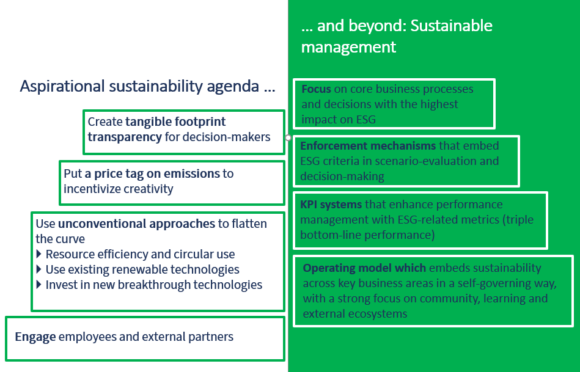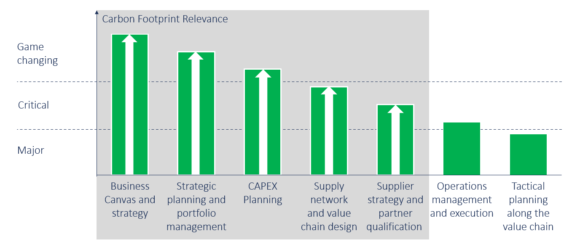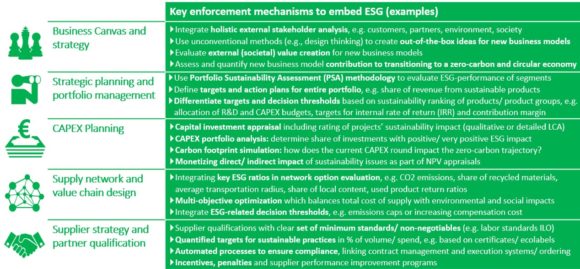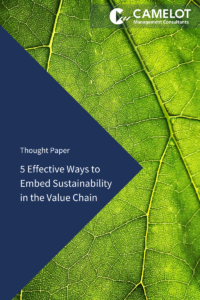In the past years, many companies have dedicated significant efforts to improve transparency and performance in the environmental, social and governance (ESG) area, and launched many initiatives to respond to the pre-eminent climate crisis. However, to truly address the magnitude of the challenge and become frontrunners in a low-carbon economy, companies need to deeply embed sustainability in the heart of their business operations by focusing on the business processes and decisions with the highest impact and implementing effective enforcement mechanisms for ESG.
Here we are now at the beginning of 2021 and the urgency for change becomes abundantly clear: the maximum global temperature rise of 1.5 – 2°C degrees agreed in the Paris agreement is far from being achieved when looking at the current status of global warming. The average global temperature in 2020 is set to be about 1.2 °C above the pre-industrial level.[1] Scenario calculations show that even to achieve the 2°C target, carbon emissions must already be at their maximum today and must fall rapidly from now on.[2] Therefore, it is fundamental for organizations to become climate neutral by 2030 to latest 2040. We laid out a range of actions in one of our previous articles.
It is fair to say that we have learned two key things so far: First, some actions are encouraging, but in sum clearly not fast and decisive enough. Second, the initial impacts of climate change are exceeding expectations, when we look for example at extreme weather events or the rapid snow cover reduction in the arctic regions.
The Covid-19 related decline in 2020 will of course not be able to solve these issues and also not remotely mitigate them. Even with a global pandemic, various lockdowns and limited economic activities over about 9 months, emissions only reduced by 6.4% in 2020.[3] But rather than a small dent in global emissions, we need a steep and persistent glide path to zero. This illustrates how big the challenge will be in the future.
From sustainability agenda to sustainable business transformation
Given these challenges, how can you best set up your company to become a leader in the low-carbon economy, and build a sustainable business and value chain in an agile and bold way, fully in line with the targets of the Paris agreement?
 Figure 1: From sustainability agenda to sustainable management
Figure 1: From sustainability agenda to sustainable management
Clearly, the leaders in the low-carbon economy need to go beyond implementing a portfolio of aspirational sustainability initiatives, such as investments in renewables, resource-efficient operations, and breakthrough technologies. While all of these are important and valuable contributions, the magnitude of the climate crisis requires companies to take an important step further by moving to sustainable management: deeply embedding sustainability in the core business operations and decision-making processes, at the essence of how they manage their business. Decisions impacting carbon emissions and other environmental and social aspects are taken in companies every day, and that is where we need to expand the focus of decision making towards external (societal) value creation. The future zero-carbon leaders treat sustainability not only as a sideshow or portfolio of initiatives but deeply integrate it into day-to-day processes and strategic decision making. They do not outsource zero-carbon initiatives to the sustainability function, but make it an integral part of any member in the management team.
“Zero-carbon leaders integrate sustainability and ESG deeply in day-to-day management processes, first and foremost in strategic decision making”
A blueprint for embedding sustainability in the core
While many will agree with the above aspiration, we need something more tangible and practical, an actionable blueprint for embedding sustainability in the core of management. Based on our experience in both business & value chain strategy and sustainability, we think companies need a sustainable management system with the right focus, enforcement mechanisms, KPI systems and operating model as guiding principles:
- Focus on core business processes and decisions with the highest impact on ESG
- Enforcement mechanisms that embed ESG criteria in scenario-evaluation and decision-making, guided by corporate sustainability targets
- KPI systems that enhance performance management with ESG-related metrics (triple bottom-line performance)
- Operating model which embeds sustainability across key business areas in a self-governing way, with a strong focus on community, learning, and ecosystems
In the first of two articles, we will outline the business processes and decisions with the highest impact on ESG and describe the key enforcement mechanisms that are required to embed sustainability.
Focus on processes and decisions with the highest impact on ESG
Companies need a pragmatic and focused approach to embed sustainability in their daily operations where it matters most. Rather than perfectionism, we need an 80/20 approach, making the 20% of strategic management processes which drive 80% of emissions fit for carbon zero.
Based on our experience, 5 core management decision making processes typically determine more than 80% of a company’s carbon emissions in the mid- to long-term. First and foremost, these processes need to be enhanced to drive for transparency on societal impact, balanced decision making, and incentivization including sustainability targets:
- Business Canvas and strategy
- Strategic planning and portfolio management
- CAPEX Planning
- Supply network and value chain strategy design
- Supplier strategy and partner qualification
 Figure 2: Leverage of core management processes for carbon footprint scope 1-3
Figure 2: Leverage of core management processes for carbon footprint scope 1-3
Right enforcement mechanisms to deeply embed ESG management processes
To successfully embed the ESG perspective in the management processes that matter, companies need to consequentially adapt their ways of working. Embedding ESG is not just a simple add-on or agenda point, but requires new awareness, buy-in, expertise, tools & processes, and collaboration skills not only from general managers, but also from CFOs, business controllers, heads of operations, heads of strategy and business development, and heads of procurement and their respective teams. Figure 3 gives an overview of the key approaches and enforcement mechanisms which will make a difference in transforming the 5 core strategic management processes with the highest impact on sustainability.
Figure 3: Enforcement mechanisms to embed ESG in core strategic management processes
None of the above is rocket science, but largely based on existing management tools and approaches. However, it takes a true organizational change effort to align the management team and build the necessary commitment and know-how to actually make the step. Let’s illustrate a couple of examples.
Strategic business planning needs to extend its focus to integrate ESG-related issues at the core of decision-making. This includes the introduction of approaches such as the sustainable business Canvas[4], which provides a systematic approach to include sustainability principles and external (societal) value chain creation in business model innovation processes. Similarly, strategic planning of the existing product portfolio needs to integrate the ESG performance of the different portfolio segments in order to systematically set targets for increasing the share of sustainable products and services as well as allocating precious resources like R&D, sales & marketing and capital expenditures accordingly. This can for example build on the Portfolio Sustainability Assessment (PSA) methodology as described by the World Business Council for Sustainable Development (WBCSD)[5], which has been successfully applied by many international organizations, most notably global chemicals players.
Equally important, CAPEX planning requires a significant upgrade with regards to embedding sustainability. The area that requires the most attention is the planning and management of capital expenditures, which are crucial for carbon emission reductions by investments in resource efficiency, circularity, and renewable energy in the next 3-5 years ahead. Thus, they over-proportionately impact the carbon emissions in the two critical decades until 2030 and 2040. The approaches include a systematic rating of the ESG impact across the entire CAPEX-portfolio, which can be done as simplified assessment for small and medium capital projects and as a more extensive Lifecycle Assessment (LCA) for big projects. This sets the basis for a systematic analysis and simulation how the CAPEX portfolio in the current approval process will effectively support the sustainability targets and trajectory. Concepts such as those of the Accounting for Sustainability Program[6] can be used to deeply embed sustainability in capital appraisal processes and CAPEX management.
To embed sustainability in the core of management, this is not yet sufficient. The enforcement mechanisms need to be complemented with a pragmatic and balanced performance management system and an operating model which effectively integrates the sustainability principles across the entire organization. Our second article will focus on these two aspects and will be released in the upcoming weeks.
[1] https://uol.de/f/2/dept/wire/fachgebiete/innovation/en/download/Manual_Sustainable_Business_Canvas__EN.pdf
[2] https://www.wbcsd.org/Projects/Chemicals/Resources/Framework-for-portfolio-sustainability-assessments
[3] https://www.accountingforsustainability.org/en/index.html
[4] https://news.un.org/en/story/2020/12/1079042
[5] See Christiana Figueres et al.: Three years to safeguard our climate. In: Nature. Band 546, 2017, S. 593–595.
[6] https://www.nature.com/articles/d41586-021-00090-3
We would like to thank Florian Kreitz for his valuable contribution to this article.


